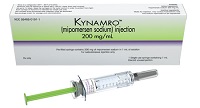 |
| Isis COO Lynne Parshall--Courtesy of Isis Pharmaceuticals |
Sanofi's ($SNY) Genzyme unit isn't offering details about its sales of Kynamro, the rare disease treatment approved last January. It's not allowing its development partner, Isis Pharmaceuticals, to dole out specifics, either. What is certain, according to Isis COO Lynne Parshall, is that the launch started off slowly, and Genzyme has expanded its sales force to step up the pace.
"What we can say is that while the launch got off to a bit of a slow start, sales showed significant quarter-over-quarter growth in 2013," Parshall said during last week's earnings call, "and we believe the sales will continue to increase significantly this year."
With Kynamro (mipomersen) slow out of the gate, Genzyme has increased its rep force to support the anticipated growth in sales, Parshall said. As the year goes on, "we expect to see returns from this increased investment" in marketing, she added.
Kynamro won FDA approval last January to treat homozygous familial hypercholesterolemia (HoFH), a rare disorder that causes ultra-high levels of "bad" LDL cholesterol. It hit the market at virtually the same time as its head-to-head competitor, Juxtapid (lomitapide), from Aegerion Pharmaceuticals, and at a price significantly lower--$176,000 for Kynamro, compared with $235,000 to $295,000 for Juxtapid.
There are other talking points on each side: Kynamro is injectable, where Juxtapid is a pill. Kynamro is taken once a week; Juxtapid is dosed daily. Both drugs carry black-box warnings about liver toxicity, and the FDA requires healthcare providers to be certified to prescribe them and pharmacies to dispense them. The FDA ordered four post-marketing safety studies for Kynamro, partly because of worries about abnormal growths that cropped up in some clinical trial patients, some of which were malignant.
If analysts give Juxtapid the advantage on side effects, they also acknowledge Genzyme's hard-won expertise at marketing and distributing rare-disease drugs. Unlike mass-market drugs, they don't launch and then take on a life of their own. With rare-disease drugs, every patient is shepherded through the reimbursement process. Many patients get payment assistance, whether from the company or from patient groups. And patient relationships are managed as therapy continues.
 |
| Kynamro--Courtesy of Genzyme |
Genzyme knows this process well. It's been working with patients who use its rare-disease drugs Fabrazyme, Cerezyme and Myozyme for years. And it hasn't been easy; when the company's manufacturing foundered and supplies constricted, Genzyme had to contend with rationing, dose restrictions and plenty of unhappy patients.
All that experience is coming in handy as Genzyme works with payers and doctors on Kynamro; Parshall noted that the Sanofi unit is chipping away at reimbursements. "Genzyme tells us that the reimbursement process is working well and they are successfully working with payers to move patient expeditiously from prescription to drug," she said during the call.
Another key element is certifying doctors. "There are hundreds of physicians who haven't certified to prescribe Kynamro," Parshall said. "We believe that the increased number of prescribers will translate into increased prescriptions."
As Medical Marketing & Media notes, Aegerion posted net product sales for 2013 of about $48 million, and Juxtapid is its only drug. The company actually hiked its sales forecast mid-year last year because Juxtapid was doing so well. Absent real figures from Sanofi or Isis, there's no way to compare dollar-for-dollar. That will change soon enough.
- see the MM&M story
Special Report: Top 20 Orphan Drugs by 2018